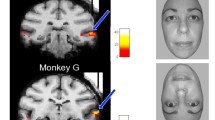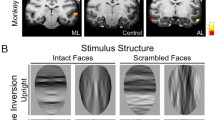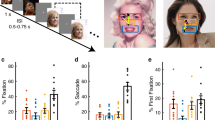Summary
Single neurons were recorded in the inferotemporal cortex (IT) of a monkey trained to discriminate three selected human faces from a large number of different faces. Neurons which were not responsive to non-face visual stimuli used in the task but were responsive to certain sets of faces were found in the gyrus of the IT. The correlation analysis between the quantified facial features and the responses has revealed that face neurons detect the combination of the distances between facial parts such as eyes, mouth, eyebrows, hair, and so on. One of the face neurons detected the combination of the degree that the forehead above the left eye covered with hair and the distance between the eyes and the mouth. The results of this analysis have given appropriate reason for naming the neurons as the face neurons.
Similar content being viewed by others
References
Bruce CJ, Desimone R, Gross CG (1981) Visual properties of neurons in a polysensory area in superior temporal sulcus of the macaque. J Neurophysiol 46: 369–384
Desimone R, Albright TD, Gross CG, Bruce CJ (1984) Stimuluselective properties of inferior temporal neurons in the macaque. J Neurosci 4: 2051–2068
Ellis HD, Shepherd JW, Davies G (1975) An investigation of the use of the photofit technique for recalling faces. Br J Psychol 66: 29–37
Haig DN (1984) The effect of feature displacement on face recognition. Perception 13: 505–512
Iwai E (1978) The visual learning area in the inferotemporal cortex of monkeys. In: Ito M, Kodansha I (eds) Integrative control functions of the brain, pp 419–427
Iwai E (1985) Neuropsychological basis of pattern vision in macaque monkeys. Vision Res 25: 425–439
Kendall MG (1980) Multivariate analysis, 2nd edn. Charles Griffin, England
Perrett DI, Rolls ET, Caan W (1982) Visual neurons responsive to faces in the monkey temporal cortex. Exp Brain Res 47: 329–342
Perrett DI, Smith PAJ, Potter DD, Mistlin AJ, Head AS, Milner AD, Jeeves MA (1984) Neurons responsive to faces in the temporal cortex: studies of functional organization, sensitivity to identity and relation to perception. Human Neurobiol 3: 197–208
Perrett DI, Smith PAJ, Potter DD, Mistlin AJ, Head AS, Milner AD, Jeeves MA (1985) Visual cells in the temporal cortex sensitive to face view and gaze direction. Proc R Soc Lon B223: 293–317
Sato T, Kawamura T, Iwai E (1980) Responsiveness of inferotemporal single units to visual pattern stimuli in monkeys performing discrimination. Exp Brain Res 38: 313–319
Seltzer B, Pandya DN (1978) Afferent cortical connections and architectonics of the superior temporal sulcus and surrounding cortex in the rhesus monkey. Brain Res 149: 1–24
Yamane S, Kaji S, Kawano K, Hamada T (1987) Responses of single neurons in the inferotemporal cortex of the awake monkey performing human face discrimination task. Neurosci Res S5: 114
Author information
Authors and Affiliations
Rights and permissions
About this article
Cite this article
Yamane, S., Kaji, S. & Kawano, K. What facial features activate face neurons in the inferotemporal cortex of the monkey?. Exp Brain Res 73, 209–214 (1988). https://doi.org/10.1007/BF00279674
Received:
Accepted:
Issue Date:
DOI: https://doi.org/10.1007/BF00279674




